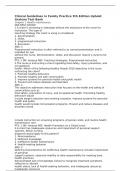Exam (elaborations)
Clinical Guidelines in Family Practice 5th Edition Uphold Graham - Test Bank
- Module
- Nursing Test Bank
- Institution
- Nursing Test Bank
Clinical Guidelines in Family Practice 5th Edition Uphold Graham Test Bank Chapter 1 Health maintenance MULTIPLE CHOICE 1.A client is reviewing a videotape without the assistance of the nurse for instruction. The type of teaching strategy this client is using is considered: 1. demonstratio...
[Show more]



